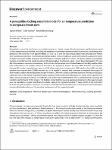Item Infomation
Full metadata record
| DC Field | Value | Language |
|---|---|---|
| dc.contributor.author | Mollick, Tajrian | - |
| dc.contributor.author | Hashmi, Galib | - |
| dc.contributor.author | Sabuj, Saifur Rahman | - |
| dc.date.accessioned | 2023-10-02T08:41:22Z | - |
| dc.date.available | 2023-10-02T08:41:22Z | - |
| dc.date.issued | 2023 | - |
| dc.identifier.uri | https://link.springer.com/article/10.1007/s44274-023-00014-0 | - |
| dc.identifier.uri | https://dlib.phenikaa-uni.edu.vn/handle/PNK/9404 | - |
| dc.description | CC-BY | vi |
| dc.description.abstract | Bangladesh is one of the world’s most susceptible countries to climate change. Global warming has significantly increased surface temperatures worldwide, including in Bangladesh. According to meteorological observations, the average temperature of the world has risen approximately 1.2 °C to 1.3 °C over the last century. Researchers and decision-makers have recently paid attention into the climate change studies. Climate models are used extensively throughout the nation in studies on global climate change to determine future estimates and uncertainties. This paper outlines a perceptible stacking ensemble learning model to estimate the temperature of a tropical region—Cox’s Bazar, Bangladesh. | vi |
| dc.language.iso | en | vi |
| dc.publisher | Springer | vi |
| dc.subject | air temperature prediction | vi |
| dc.subject | tropical climate zone | vi |
| dc.title | A perceptible stacking ensemble model for air temperature prediction in a tropical climate zone | vi |
| dc.type | Book | vi |
| Appears in Collections | ||
| OER - Khoa học môi trường | ||
Files in This Item:

